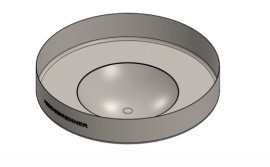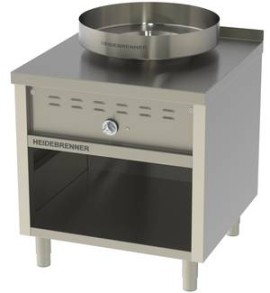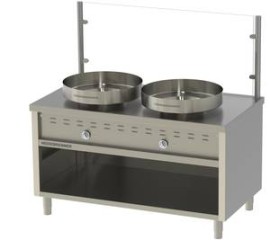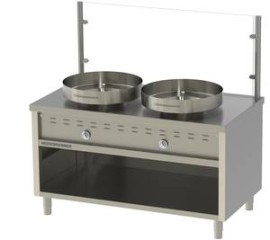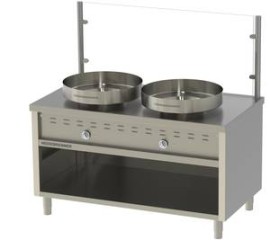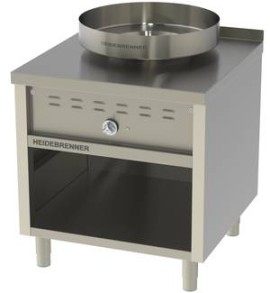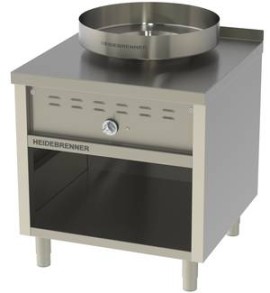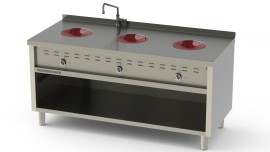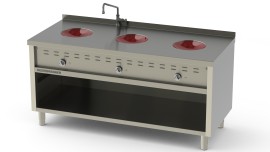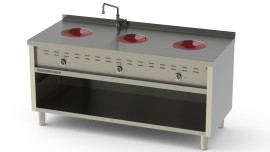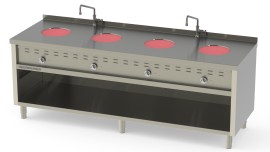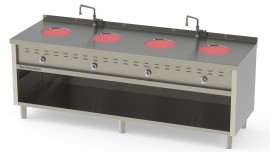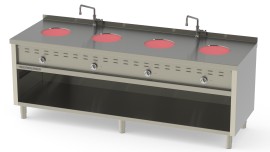What is Tantuni?
Origin
The dish Tantuni originally comes from the southern Turkish region of Mersin. It has since spread widely in many parts of Turkey, but also in other countries such as Germany. This dish is particularly popular as a quick snack, as it is easy to prepare and to eat.
Preparation
The chosen meat – usually beef, but also chicken or lamb – is cut very finely and first cooked in a little water until tender. Then marinate it with spices such as paprika, cumin, garlic, and salt and fry it in the Tantuni pan shortly before eating until crispy brown.
Traditionally, you serve the meat in a thin pita bread pocket or rolled up in yufka dough. Just before serving, place a yufka sheet or a piece of pita bread on top of the meat in the special trough of the tantuni pan. This warms it up. The yufka leaf also becomes soft and ready to eat. Now fill the chosen pastry shell with the juicy meat and spice mixture and arrange it on a plate. At street food stalls, the tantuni is wrapped in a napkin or aluminium foil to take away.
Serve
Serve with fresh lettuce, tomatoes, onions, and parsley. A spicy or garlicky sauce is just as indispensable as a slice of lemon on the side and a dollop of yoghurt on the tantuni.
More than just street food
In the past, tantuni was mainly considered a “poor man's food”, a leftover meal that used more vegetables and only a little meat. Nowadays, restaurants are increasingly acquiring a taste for this hearty, versatile dish from Turkish cuisine. In this case, high-quality cuts of veal, lamb, or chicken are primarily used.
In addition to the classic core ingredients and side dishes, a variety of other ingredients are possible. Mushrooms or peppers, for example, can refine the meat mixture, or French fries, grilled peppers or tomatoes and pickled peppers can serve as side dishes.
Restaurants with a focus on Turkish, Arabic, or Levantine cuisine thus expand their menu selection. But also, gastronomic establishments with a different cuisine have another tasty dish on the menu with Tantuni. Thanks to the variety of ways this dish can be served, every professional chef gets the chance to leave their own culinary impressions here.
What is a tantuni pan, and what makes it special?
If you want to prepare the Turkish dish in the original way, you should use a tantuni pan. Basically, it is a large, flat pan. However, some features make this cooking utensil special: the pan is very large and has only a very narrow rim. There is also a hollow in the centre.
Plenty of space for stirring
The size of the pan allows enough space for the meat and spices to sear and mix. This ensures that everything is cooked thoroughly at the same time. Stirring and turning the ingredients is made easier by the very low rim.
For a juicy result
The hollow in the middle of the HEIDEBRENNER Tantuni pans is used to deglaze the meat mixture with the liquid that has escaped during roasting or cooking stock and spices. The meat simmers in this for a short time. This gives the mixture a creamy sauce, which makes the tantuni dish wonderfully juicy.
Tantuni pans at HEIDEBRENNER
The Tantuni utensils and pans from HEIDEBRENNER are made of high-quality stainless steel and are ideal for use in professional gastronomy. Around the deep hollow in the middle is the shallow frying surface for larger quantities of cut meat. As a professional gastronomy supplier for large kitchens and restaurant of the highest quality, HEIDEBRENNER offers optimal technical equipment for professional kitchens – as with this special cooking equipment.
Less energy required thanks to induction: The Tantuni cookers transfer the heat to the Tantuni pans sitting on them via induction. This ensures comparatively low energy costs during preparation, even though the appliances are very powerful. On request, the wide cookers are also available for operation with gas.
High-quality materials
The HEIDEBRENNER Tantunis provide a high standard of hygiene and easy handling thanks to the selected material and high-quality workmanship. The cookers are available as freestanding versions and can thus be placed in the ideal location in any professional kitchen.
For large and small kitchens
Depending on the space available and the quantity to be prepared, you can choose between the widths of 650 mm and 1300 mm for the Tantuni appliances. The narrower versions are designed for one Tantuni pan, the wider ones for two. You also have a choice of 3.5 watts to 16 watts in terms of total appliance power. For open kitchens, we recommend the versions with two Tantuni pans, as these have a glass pane behind the cooking surfaces. This allows guests to watch the delicious meal being prepared. By the way, you can purchase separate Tantuni pans from us if required – these are compatible with all our Tantuni cookers.
FAQ
How often should I clean the Tantuni cooker and pan?
The rhythm of cleaning and maintenance depends on the frequency of use. The following recommendations apply:
Daily cleaning: You should clean the cooker and pan thoroughly after each use. Remove food residues and grease with a spatula and wipe the surface with a grill cleaner.
Weekly cleaning: Once a week, you should clean the entire appliance thoroughly.
Which material is best for a Tantuni cooker?
The material that is best suited for a Tantuni cooker as well as the matching pan is stainless steel. It is ideal for intensive use in professional kitchens. It has excellent heat conductivity and is also resistant to corrosion and rusting. Stainless steel is also easy to clean and maintain, which is important for restaurants. .
Induction wok stations are available, for example, with 1, 2 or 4 induction wok cooking zones with either 8, 16 or 24 kW power. In addition, warming containers with an output of 2 kW can be integrated.
Where does the dish Tantuni come from?
This dish originates from the south-eastern Turkish region of Mersin. There, it has always been a popular street food tradition. By now, this dish can be found throughout Turkey as well as in other countries.


